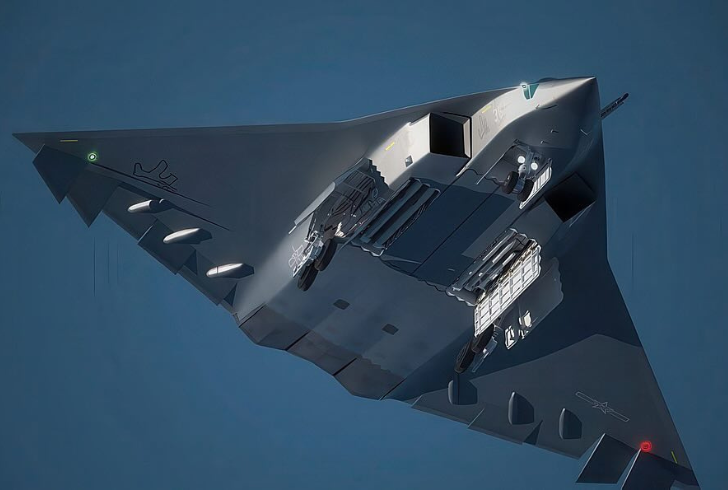The recent appearance of a mysterious, tailless fighter jet from China has stirred serious conversations among military experts worldwide. Not only is the aircraft’s shape and engine configuration different from anything seen before, but its existence points toward a significant leap in military aviation technology.
As speculation swirls, new photos and videos of this aircraft—believed by many to be China’s next-gen fighter—are gaining attention fast.
A Closer Look at the Aircraft Raising Eyebrows
Footage shared online shows the aircraft flying near Chengdu Aircraft Industry Group, which is widely known for producing China’s advanced fighter jets. What sets this aircraft apart is its trijet engine configuration, a major departure from the more common twin-engine designs seen in most current-generation fighters.

Military analyst David Cenciotti observed that this unique setup, with two air intakes beneath the wings and a third intake positioned just behind the cockpit, could provide added benefits.
According to him, this could improve engine performance and offer better backup in case of engine failure, something crucial in high-risk air combat situations.
What’s Hiding Underneath?
Observers have noticed a space between the landing gears that might be more than just structural. This gap could house internal bays for large, long-range missiles. These hidden compartments would keep weapons out of sight, helping the jet remain stealthy during missions.
Some experts say this could be a real move toward a sixth-generation fighter. For now, the US holds the edge with the F-22 and F-35, both loaded with stealth and advanced tech. But with this new reveal, China may be closing the gap—and fast.
What Makes It Different From the U.S. Arsenal
Currently, the US dominates the sky with its fifth-generation F-22 and F-35 jets, which are known for their stealth, agility, and advanced systems. However, this newly spotted fighter could mark China’s effort to catch up or even outpace its rival in advanced combat aviation.
Brad Lendon of CNN commented that this aircraft could allow China to stand shoulder-to-shoulder with the US—or possibly take the lead—as the world edges closer to sixth-generation air power.
The Race for Sixth-Generation Supremacy
The term “sixth-generation” refers to aircraft that go beyond the stealth and sensor capabilities of current jets. This includes autonomous operations, enhanced artificial intelligence support, optional piloting, and advanced drone teaming.
Former President Donald Trump recently made waves with his announcement about Boeing’s development of the F-47, a fighter he claimed had been flying secretly for five years. In his statement, he described it as a game-changer, highlighting its ability to operate alongside multiple drones—something current jets haven’t yet mastered.
He emphasized, “This isn’t just a fighter jet. It flies with many drones at once—more than you can count. It’s a whole new approach to air combat that no one else has.”
China’s Momentum Isn’t Slowing

On the same day that footage of the tailless J-36 appeared online, images of another advanced jet surfaced too. This one had twin engines and a similar, stealthy, tailless body. Some called it the J-50 or J-XX. Even though there’s no official name or confirmation yet, it’s clear something big is in development.
So far, China’s People’s Liberation Army (PLA) has stayed silent on both jets. But the images and expert reviews speak volumes. Wang Ya’nan, a top editor at “Aerospace Knowledge” magazine, said China seems focused on exploring new ideas in aviation. That focus likely includes stealth, speed, and autonomy.
Why the World Is Watching Closely
Here’s why this matters:
1. Trijet Configuration – Offers better performance and extra engine security.
2. Internal Weapon Bays – Help keep the jet invisible to radar.
3. Stealth Design – A tailless frame reduces drag and radar detection.
4. Drone Teaming Potential – Opens the door to next-level combat coordination.
With these features in play, China could be shifting from a follower in aviation tech to a real contender. The speed of this progress has many in the global defense space paying close attention.
A Bigger Message in the Skies
This new jet may be more than just another aircraft. It sends a message that China is serious about competing in the race for air dominance. While there’s still much to learn, it’s clear this isn’t just a test model—it could be a game-changer.
As more footage and expert analysis surface, the global conversation keeps growing. Whether it’s the J-36, the J-50, or a completely new name, one thing is certain: China is moving fast, and the world is watching.
This is more than a new plane. It could be the start of a new chapter in global airpower. And for now, all eyes are on China.

